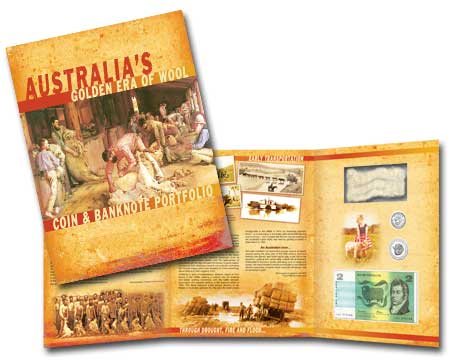 Includes real Merino WOOL!
Includes real Merino WOOL!
Headlined by a large piece of genuine Australian Merino wool – as well as three Australian legal tender issues – this inspired presentation forms the most fitting possible tribute to the crucial role of the Australian Wool Industry in the economic, political and cultural development of Australia.
The key to the tremendous worldwide success of the Australian Wool Industry from the colonial period to the modern age, Merino wool is renowned as the whitest, softest and most lavish natural fibre. An imaginative addition to a presentation defined as much by its great originality as its outstanding collector value, the authentic piece of Merino wool is the perfect complement to the two coins and one banknote found in the 2011 Australia’s Golden Era of Wool Coin &
Banknote Portfolio.
To be enshrined in legal tender is to receive the ultimate recognition, and, illustrating the importance of wool to the Australian nation, the Commonwealth Government has authorised several legal tender issues devoted to the Australian Wool Industry. Issued between 1938 and 1963, with the design based on Uardry 0.1, a champion ram at the 1932 Sydney Sheep Show, the Ram’s Head Silver Shilling is arguably Australia’s most memorable predecimal issue. Three years after the last shilling was struck, Australia’s $2 note was first issued, bearing the portrait of ‘The Father of the Merino Industry’, John Macarthur. Twenty-five years later, the 1991 Decimal Currency 25th Anniversary 50c was unveiled, bearing an inspired design based on the original Shilling Ram’s Head motif.
The perfect combination with which to honour the Australian Wool Industry, examples of the last Australian $2 note, the Elizabeth II 1953-63 Shilling and 1991 50c Decimal 25th Anniversary are united with the Merino wool in the 2011 Australia’s Golden Era of Wool Coin & Banknote Portfolio – all in pristine Uncirculated condition! Set within a large, impressive full-colour pack, featuring the history of the wool industry and a superb range of photos, this brilliant collection is sensational value-for-money at just A$69.95.
- Headlined by a large piece of genuineAussie Merino wool!
- Includes the 1985-88 Johnston/Fraser$2 note – in Unc quality
- Features a 1953-63 Silver Shilling in Unc– date of our choice
- Highlighted by the 1991 Decimal25th Anniversary 50c in Unc
- Housed within an illustrated, informativepresentation pack
- Absolutely fantastic value-for-money at just A$69.95!
Remarkable for the influence of a single breed – the Merino – the Australian wool industry was our major source of export income from the colonial period to the 1970s. However, beyond being key to the economic well-being of the nation, the history of the wool industry had a dramatic impact on Australia’s social, cultural and political development, playing a decisive role in the creation of the Australian national identity.
Sheep arrived with the First Fleet in 1788, but it wasn’t until the introduction of Merinos that the wool industry began its journey to become Australia’s number one export – in large part due to the efforts of John Macarthur. One of the earliest settlers, Macarthur was the first Merino breeder, and a tireless campaigner for the export of wool to Britain in the early 19th century. Although others made a significant contribution to the history of Australian wool production, Macarthur’s vision, large scale wool export and support for the trade has seen him enshrined as ‘The Father of the Merino Industry’. In part due to the turmoil in Europe created by the Napoleonic Wars, the wool industry’s first boom time took place after 1813, with the first significant British auction of Australian wool taking place in 1821.
Whilst the industry subsequently thrived, the 19th century was dominated by bitter conflicts between pastoralists and shearers. Whilst a lucrative business, logistical difficulties did bring heavy costs, and although advances such as mechanised shears and the replacement of shepherds with fencing, did ease the burden, employers still tried to cut costs by controlling shearers’ wages. United by a spirit of comradeship, shearers formed unions in the 1880s, with the battle against the pastoralists culminating in the shearer’s strike of 1890. This failed industrial action proved decisive to the history of Australian political life, with the first ALP branch meeting held in Queensland by striking shearers in 1891.
Battling through drought, flood and fire, as well as two World Wars and the Depression, the wool industry remained Australia’s primary source of export income until the late 20th century. Continuing to play a key role in Australian life, the wool industry’s contribution to our national identity means that, to some extent, Australia will always ‘ride on the sheep’s back’.

For more information or to purchase online, please click on the appropriate link:
Australia
North America






